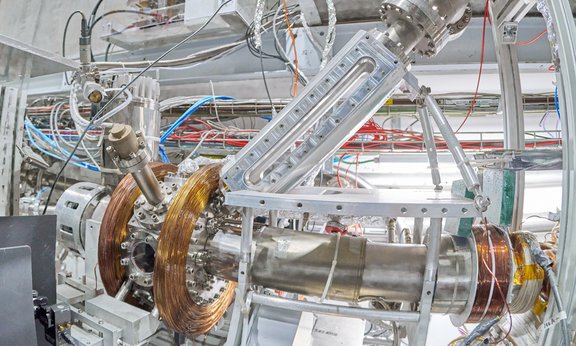The device at CERN in Geneva in which the experiment was conducted.
An international team of scientists, including Giovanni Circiari of the University of Innsbruck, has demonstrated laser cooling of positronium, which consists of an electron and a positron, its antiparticle. This work represents a major advance in understanding and working with antimatter, and provides a new basis for future experiments and technological advances.
Positronium is an exotic atom consisting of an electron and its antiparticle, the positron. Scientists from Aegis Collaboration At CERN it is now possible to lower the temperature of the positronium cloud from 380 K to 170 K. Key to this success was the development of a broadband laser system with a wavelength of 243 nm suitable for the 1S-2P triplet transition of positronium. Giovanni Circiari of the Institute of Experimental Physics at the University of Innsbruck set up and maintained the laser for positronium spectroscopy. “This is the first demonstration of laser cooling of an exotic matter-antimatter system, and thus of an atom consisting only of leptonic matter,” Cerchiari says. The AEgIS collaboration aims to use laser-cooled positronium as a precursor to the formation of antihydrogen atoms, which are antihydrogen particles. The use of laser-cooled positronium will improve the production of antihydrogen, which will then be used to precisely measure the free fall of antimatter in Earth's gravitational field. This experiment aims to set a new milestone in testing the equivalence principle in general relativity for antimatter and could reveal the asymmetry between matter and antimatter.
This advance affects multiple areas of physics and may form the basis for new experiments and technological advances. “Some examples of this include studying fundamental physics beyond the confines of the Standard Model of particle physics, exploring the possibility of using gamma-ray lasers to resolve Bose-Einstein condensates with antimatter, and verifying the principle of equivalence of gravity with antimatter in a purely leptonic system,” says Giovanni Circiari. And the use of sensitive positronium annihilation to study the microscopic properties of materials.”
existing now Physical review letterThe published work provides a comprehensive analysis of the experiment and its implications. This study, along with a similar study conducted by a Japanese team, will provide a new basis for future developments in physics research.
Publications:
Positronium laser cooling via 13D-23P transition with a broadband laser pulse. L. T. Glogler et al. fi. Rev. Lit. 2024 digital ID:
10.1103/PhysRevLett.132.083402arXiv:2310.08760
Positronium laser cooling. Xu et al. arXiv:2310.08761

“Social media evangelist. Baconaholic. Devoted reader. Twitter scholar. Avid coffee trailblazer.”







More Stories
These brands are most vulnerable to phishing scams
Apple Maps Now Has a Web Version and Wants to Challenge Google Maps
Best AirDrop Alternatives for Android